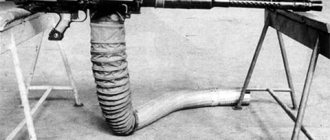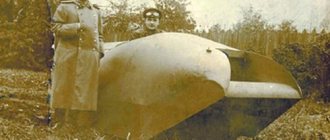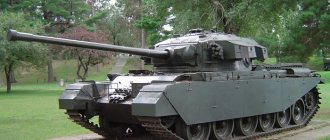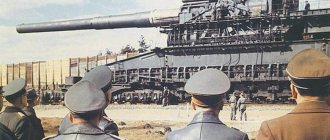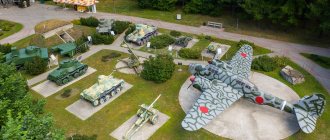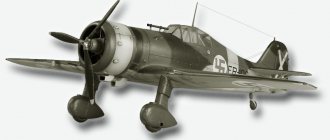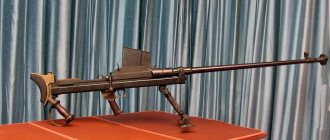At the end of the 30s, the Red Army had an original class of light-weight tracked vehicles, adapted to independently overcome water obstacles. To move on water, the tank needed to slide into the water, then the driver connected the propeller through the power take-off gearbox. The steering wheel was used to change the direction of movement.
But the existing vehicles gradually became obsolete, and they were replaced by the T-40 tank, which was distinguished by increased seaworthiness and enhanced armament. Theoretically, the vehicle could be used as an armored boat, but the outbreak of war led first to the cessation of production of amphibious tracked vehicles, and then to the complete disappearance of the class.
History of creation
By the end of the 30s, the Red Army had two types of light amphibious vehicles - T-37A and T-38, created on the basis of the British Carden-Lloyd vehicle. The vehicles had weak armament, but the main problem was low seaworthiness and the lack of possibility of modernizing the design. At the beginning of 1939, development of a project for a new machine began, work was carried out in the bureau of Moscow plant No. 37, N.A. became the chief designer. Astrov. The vehicle, designated 010, was based on the solutions incorporated in the design of the T-38.
By the summer, a batch of 4 cars was built, equipped with suspensions of various designs. A series of prototypes used the American Dodge D5 power unit, since the Soviet analogue had not been mastered by industry. During the tests, shortcomings were noted, which were promptly eliminated. The largest modification was the lengthening and widening of the hull.
At the end of 1939, the Project 010 tank was put into service under the designation T-40; the start of mass production was planned for 1940.
Production continued until the start of the war, and then plant No. 37 was planned to be switched to the production of medium-sized T-50 vehicles. But due to the cancellation of the order in July 1941, the series went into production of a land version (designated in historical literature as T-40S, the index was not used in army documentation), which was distinguished by the absence of propeller lines and some of the components used when moving on water.
The hull retained a niche for installing a screw; some of the sheets began to be made of armor with a thickness of 13...20 mm. Later, the tank was modernized again, strengthening the armament and rearranging the internal compartments. The vehicles were designated T-30, becoming a stepping stone to the creation of a new Project 060 or T-60 vehicle.
A total of 960 vehicles of the T-40, 40C and 30 modifications were produced. The bulk of the vehicles were assembled in Moscow; a number of tanks were released from the parts reserve in Sverdlovsk, where plant No. 37 was evacuated.
T-40, Light tank
FLOATING TANK T-40
The T-40 light amphibious tank was developed in 1939 at Plant No. 37 under the leadership of N.A. Astrov and was intended to replace the T-37A and T-38 tanks in the army.
The T-40 hull was made of rolled armor plates, connected by welding or riveting. The stability of the tank on the water was ensured only by the shape of the hull - there were no floats. In the lower part of the stern of the hull there was a niche for installing a four-bladed propeller and two rudders. The turret, in the shape of a truncated cone, was mounted on a ball support and was offset to the left of the longitudinal axis of the tank. The engine was located along the starboard side of the hull. A twin installation of DShK and DT machine guns was mounted in the turret embrasure in the armored mantlet. To increase the rate of fire of the DShK machine gun, its ammunition was placed in a ring ammunition rack.
The T-40 tank underwent an extensive testing program, during which a run was organized along the route Moscow - Minsk - Kyiv - Moscow, with a length of 3000 km, overcoming all encountered water obstacles. On December 19, 1940, the tank was put into service. The order for 1940 was 100 vehicles, but the plant was only able to produce 41. By June 22, 1941, another 181 vehicles were produced. Thus, at the beginning of the war, the Red Army had 222 T-40 tanks.
During the very first battles, the inadequacy of the tank's armament became obvious. In the summer of 1941, a 20-mm ShVAK aircraft cannon with 154 rounds of ammunition was installed on the T-40, while the propeller and its drive were simultaneously eliminated. The latter circumstance accelerated the production process, and in a real combat situation the tank practically did not have to swim. This variant was designated T-40S (“S” – land).
On the next modification - T-30 - there was no longer a niche for the propeller - the rear hull plate was straight. Otherwise, the displacement hull remained unchanged, but the maximum armor thickness increased to 15 mm. The gun's ammunition capacity was increased to 750 rounds. It should be noted, however, that all three versions of the tank were still called T-40 by the troops. They were not separated in statistical reporting either, so it is not possible to indicate how many tanks of one or another variant were manufactured. In total, 709 T-40 tanks were produced, which, together with their “younger brother” T-60, were in service with one of the three battalions in tank brigades of a mixed organization and were used until mid-1942.
TACTICAL AND TECHNICAL CHARACTERISTICS OF THE T-40 TANK
COMBAT WEIGHT, T: 5.5. CREW, people: 2. OVERALL DIMENSIONS, mm: Length – 4035, width – 2230, height – 1905, ground clearance – 300, ARMAMENT: 1 DShK machine gun 12.7 mm caliber: 1 DT machine gun 7.62 mm caliber. AMMUNITION, cartridges: DShK – 500, DT – 2016. AIMING DEVICES: TMFP telescopic sight and mechanical sight. RESERVATION, mm: front, side, stern – 13, roof – 6, bottom – 4, turret – 10, ENGINE: GAZ-11, model 202. six-cylinder, carburetor, in-line, liquid cooling: working volume 3480 cc; power 70 hp (51.5 kW) at 3400 rpm. TRANSMISSION: engine-mounted clutch, gearbox, main (transverse) gear, final clutches with brakes, final drives CASING GEAR: four rubber-coated support rollers on board, front drive wheel with removable ring gear, idler wheel with crank tensioning mechanism , three support rollers; individual torsion bar suspension of the road wheels; each caterpillar has 87 tracks with a width of 160 mm. SPEED max., km/h: on land – 45: afloat – 6. POWER RESERVE, km: 300. OBSTACLES OVERCOME: angle of elevation, degrees. – 34, ditch width, m – 1.7, wall height, m – 0.6.
Design
The armored hull of the T-40 amphibious tank had a trapezoidal longitudinal section, with the wide part located at the top. This configuration made it possible to improve the seaworthiness of the equipment. In front was the driver's mechanic's workplace, installed almost along the axis of the car. There was a gunner in the turret, who was also the tank commander. The turret was located offset to the left side, and the power unit was located along the right side. The engine was serviced from inside the vehicle; to access the components, it was necessary to remove elements of the armor casing.
The gearbox and side clutches were placed in front of the driver's mechanic's feet, which allowed the drive wheels to be kept in the front position. A radiator is installed behind the front part of the engine (with the flywheel facing the front projection of the T-40 tank). Along the sides of the stern there are 2 symmetrical tanks for B-70 gasoline, each designed for 100 liters of liquid. The fuel supply was enough for 220 km along the chassis; there was an additional 6-liter emergency tank; fuel was supplied to the carburetor by gravity.
The T-40 used a lower-valve 6-cylinder GAZ-11A engine, which developed a power of 85 hp.
The engine design used different carburetors with rising and falling flow, and some units were equipped with a speed limiter. The transmission used a semi-centrifugal clutch and a 4-speed gearbox, unified with the GAZ-MM truck unit. The final drives had 2 spur gears.
In the rear part of the T-40 hull there was a recess in which the propeller and rudder were located. Damage protection is installed around the screw. The shaft is removed from the gearbox. The distribution of units inside the hull made it possible to provide a slight trim to the stern. To reduce flooding of the front part, a controlled reflective shield is installed.
Additionally, all hatches located on the T-40 hull were sealed. The vehicle made it possible to move through water in conditions of waves up to force 3; life jackets for crew members were placed inside.
The chassis was equipped with individual torsion bars; each side had 4 rollers with external shock absorption. Later, on the T-30, cast rollers with an internal rubber ring appeared. The chassis design had balancer travel limiters; the upper branch of the fine-link caterpillar was supported by three rollers. The tension of the caterpillar belt was carried out by a stern-located idler, externally identical to the road wheels.
To increase security, the principle of inclined installation of sheets is used.
The turret, made in the form of a truncated cone, had a height of 470 mm, which reduced the geometric height and visibility of the tank. The body sheets were connected by welding, with the seams located from the inside. This ensured that the top layer of the sheets remained solid, cemented and hardened.
Bullet-resistant rivets were used to a limited extent to strengthen connections. The upper sheets of the body are mounted on bolts, the tightness is ensured by a tarpaulin gasket coated with red lead.
The thicknesses and angles of inclination of the sheets are shown in the table. The T-40's protection was not penetrated by an armor-piercing rifle-caliber bullet at all distances and at any angle of impact.
| Part type | Thickness, mm | Angle of inclination, degrees. | |
| T-40 | T-40S | ||
| Body forehead | 13 | 20 | 25 |
| Hull nose | 10 | 15 | 30 |
| Board | 10 | 15 | 0 |
| Side niches | 10 | 15 | 22 |
| Stern | 9 | 13 | 30 |
| Bottom | 4-6 | 5 | 90 |
| Roof | 6 | 5 | 90 |
| Tower | 10 | 20 | 25 |
The T-40's armament consisted of a 12.7 mm DShK machine gun paired with a 7.62 mm DT barrel. The firing range from large-caliber weapons reached 4000 m. The ammunition included armor-piercing and armor-piercing incendiary bullets, which ensured 100% penetration of a vertical armor plate 16 mm thick at a distance of 300 m. The ammunition consisted of 450 rounds of ammunition placed in 9 interconnected belts.
Inside the tank there was an additional belt for 50 rounds. There were 2016 rounds of ammunition for the DT machine gun, the magazines were stacked along the left side. Crew members had the opportunity to fire through hatches closed with steel plugs. F-1 grenades were used for additional protection.
During the war, work was carried out to enhance the firepower of the T-40 light tank; several experimental vehicles with 23 and 20 mm guns were created. Parts of the T-40S of later production were equipped with a 20 mm TNSh cannon, created on the basis of an aircraft model. The ammunition included shells with a tungsten core, which penetrated 25 mm thick armor from a distance of 50 m.
A number of T-40s were converted to accommodate missile guides.
The DShK was aimed using an optical sight with night illumination. Turning and changing the angle of inclination of the trunks was done manually. On the turret ball chase there are hooks that prevent the unit from separating when the T-40 tank is tilted. The review was carried out through viewing devices equipped with glass armor blocks.
For orientation when moving through water, a magnetic compass was used. Some of the T-40s, equipped as command ones, were equipped with a radio station with a range of up to 15-16 km. A light-signal system was used for communication between crew members.
Brief description of the T-40.
The crew of the T-40 tank consisted of a driver and commander, located one behind the other, near the longitudinal axis. The tank's turret is offset by 0.25m to the left side of the tank.
The T-40 was armed with a twin installation of a heavy-caliber DShK machine gun and a 7.62-mm DT tank. The tank's turret is cone-shaped, containing in a special box the main part of the heavy machine gun's ammunition - nine interlocking belts out of ten for a heavy machine gun. Thus, the necessary continuity of power supply and rate of fire of the DShK was achieved. Unlike previous tanks, to make aiming easier, the T-40 was equipped with a TMFP optical sight.
The Dodge T-40 engine was installed along the starboard side, the transmission was installed in the front part of the hull. The engine is separated from the fighting compartment by an armored partition. Fuel tanks, each with a capacity of one hundred liters, were located in the rear of the tank, providing a cruising range of 220 km. On the right, between the engine and the side, used when moving on water, are the radiator and heat exchangers.
Movement through the water was provided by flat rudders and a three-blade propeller. To protect against damage, they are placed in a niche in the rear of the T-40 tank. Power is taken from the motor to rotate the propeller using a propeller shaft, using a power box installed on the gearbox.
For observation, there were three optical instruments for the driver (one in each of the sides and the front plate), and one for each of the sides of the turret for the commander.
Torsion bar suspension similar to the experimental suspension of the Komsomolets and T-38 tractors. From the drive and guide wheels, three support and four support rollers, applied to the board. There was also a T-40 version with a spring suspension similar to that of the Komsomolets tractor. In addition to the suspension, the tanks differed in the type of gearboxes and engines used:
- The T-40 tank with spring suspension had a 76 horsepower Dodge engine, a Ford truck clutch and a Dodge gearbox;
- Tank with a torsion bar 85 horsepower Dodge engine, clutch and gearbox of a GAZ-AA truck.
Both versions of the T-40 were tested during the last two summer months of 1939. They tested the working conditions of the tank crew, weapon guidance devices, and the tank’s ability to overcome both water boundaries and artificial obstacles.
Briefly, the test results can be summarized as follows:
- torsion bar suspension is preferable to spring suspension;
- The cooling system is not working satisfactorily;
- lack of ventilation and, as a result, high smoke levels in workplaces;
- the installation of weapons and surveillance devices has not been finalized;
- the design of the rollers is unsatisfactory;
- existing shortcomings should be eliminated at the development stage in the production of the T-40 tank.
Based on the test results, manufacturer No. 37 introduced a significant number of improvements aimed at increasing the reliability of the T-40 tank. First of all, the changes affected the body, road wheels, tracks and torsion shafts. The Dodge engine was supposed to replace the domestic GAZ-202. The propeller was replaced with a new one with four blades. In this form, the T-40 was accepted into service. The plan for plant No. 37 provided for the production of at least one hundred tanks in 1940, with the first experimental vehicles to be presented no later than March.
Drawing of the T-40 amphibious tank produced in 1941.
Drawing of a non-floating tank T-40s produced in 1941.
T-40 tank armor scheme
T-40s tank armor scheme
Performance characteristics in comparison with enemy analogues
The T-40 tank, which allows movement on water, has no direct foreign analogues. The only vehicle adapted to overcome water obstacles is the Japanese Ka-Mi, equipped with external floats. When using the tank on the ground, the floats were dismantled.
When installing pontoons, the weight of the vehicle increased by 3 tons, reaching 12,500 kg.
| T-40 | Mitsubishi Ka-Mi | |
| Combat weight, kg | 5500 | 9500 |
| Crew, people | 2 | 5 |
| Length, m | 4,11 | 4,83 |
| Width, m | 2,33 | 2,79 |
| Height, m | 1,905 | 2,34 |
| Armament | 1x12.7 mm and 1x7.62 mm machine guns | 37 mm cannon and 2x7.7 mm machine guns |
The Japanese tank was equipped with a diesel engine, which accelerated the vehicle along the highway to 37 km/h; when afloat, the equipment moved at a speed of 10 km/h. The chassis used a sloth, lowered to the ground surface. In this way it was possible to reduce the specific pressure. The Soviet car was capable of accelerating to 44 and 12 km/h on highways and water, respectively.
Combat use
By the beginning of the summer of 1941, only 132 copies of the T-40 tank were in the active army, but only vehicles from training units were in active use. Most of the tanks were lost by mid-summer. For example, units of the Southwestern Front lost 84 vehicles out of the 88 available during a month of fighting. The abandoned equipment was not of interest to the advancing German army - the T-40 did not even have a German designation. At least one captured tank was used by Romanian units.
The land version of the T-40S is not separated from the T-30 tanks in unit reports. The equipment was supplied to the army in late summer and early autumn of 1941 and was used on all fronts. Due to the current difficult situation, the vehicles were used as linear tanks and were almost never used for reconnaissance. By the end of the summer of 1942, almost all existing T-40s were destroyed; several vehicles were used in training units and reserve regiments. The last mention of the operation of the T-40 dates back to 1946.
A trace in history and gambling addiction
The T-40 tank became the crown of development of light tracked vehicles, adapted to overcome water obstacles. A new design did not appear during the war, and after 1945 no one remembered such tanks. Instead of tracked floating vehicles, wheeled vehicles equipped with a tire pressure regulation system began to be used.
To this day, one original T-40S tank (equipped with ShVAK) has survived, which is kept on display in Kubinka.
The original T-40 vehicle has not been preserved in any form; not even the wreckage of such a tank has been found. Despite its low distribution, the tank is found in the games Sudden Strike and Panzer General III.
On the market of prefabricated models, a plastic copy of a tank on a scale of 1-35 is produced only using molds from the Moldovan company AER. The equipment was made more than 15 years ago, the quality and workmanship of the castings leaves much to be desired.
Main modifications of the T-40 small tank
- T-40 - Basic model. Displacement welded hull. The turret in the shape of a truncated cone is shifted to the left side, and the engine is shifted to the right. Ability to move afloat.
- T-40S - Land version. A propeller with a cardan drive, a power take-off, water rudders, a bilge pump, a water shield, a heat exchanger, and a compass were seized.
- T-30 - Land version. Straight hull stern plate without propeller niche. Reservations: front and side of the hull - 15 mm, turret - 20 mm. Some of the tanks were equipped with a 20-mm TNSh-20 (ShVAK) automatic cannon and a coaxial DT machine gun. Ammunition: 750 rounds and 1512 rounds.
Based on the T-40 tank, a small number of BM-8-24 missile launchers were manufactured, which were used until the end of the war. Individual vehicles were used as training vehicles until 1946.

